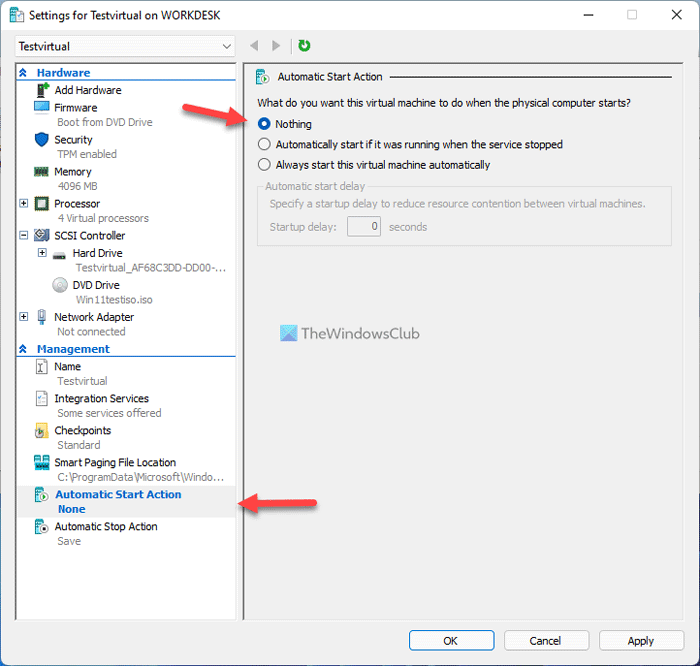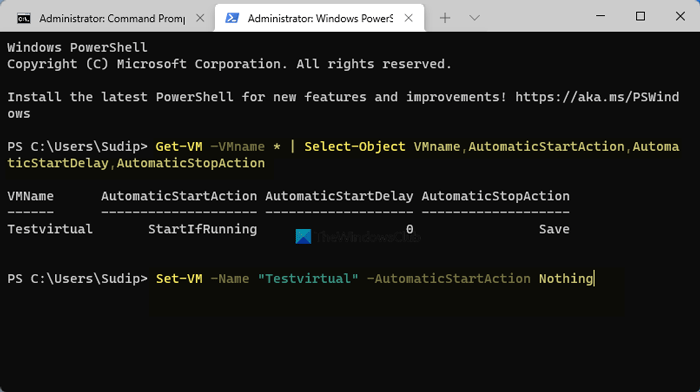By default, Hyper-V doesn’t start the virtual machine when you log into your user account. However, if you want to allow Hyper-V to launch the virtual machine automatically at Windows startup, here is how you can do that. This post will also show you how to block Hyper-V from starting the virtual machine at startup.
Hyper-V mainly offers three launch options:
- Nothing: If you choose this option, Hyper-V won’t start the virtual machine when you start your computer.
- Automatically start if it was running when the service stopped: At times, we restart our computer suddenly when it freezes or hangs a lot. If Hyper-V was running when you restarted the computer, Hyper-V will run the virtual machine automatically when you start your PC.
- Always start this virtual machine automatically: If you choose this option, Hyper-V will start the virtual machine automatically at startup. Whether it was running when you restarted your PC or not, Hyper-V will start the selected virtual machine without any prior permission.
It is also possible to delay the start of the virtual machine. This helps when you want it to start automatically but wait for a few moments first. It is possible to set this up with the help of the Hyper-V Manager as well as PowerShell. We have mentioned both methods and you can follow either of them at your convenience. Before getting started, you must know that you can enable this setting for each virtual machine manually.
How to make Hyper-V virtual machine launch automatically at startup
To make Hyper-V virtual machine launch automatically at startup on your Windows computer , follow these steps:
- Open Hyper-V Manager on your PC.
- Select a virtual machine.
- Click the Settings option.
- Switch to the Automatic Start Action tab.
- Choose Nothing to block.
- Choose Always start this virtual machine automatically to allow.
- Click the OK button.
To get started, open the Hyper-V Manager on your PC and select a virtual machine you created earlier. Then, click the Settings option visible on the right-hand side.
Alternatively, you can right-click on the virtual machine and select the Settings option from the context menu.
Then, switch to the Automatic Start Action tab on the left side. Here you can find all the options mentioned above. You need to choose Nothing to block Hyper-V from starting the virtual machine.

On the other hand, if you want to allow Hyper-V to start the virtual machine at startup, you must choose the Always start this virtual machine automatically option.
Once done, click the OK button to save the change. It is also possible to set the start delay. For that, you need to enter a value in seconds in the Startup delay box.
Stop Hyper-V from starting the virtual machine at startup using PowerShell
To stop Hyper-V from starting virtual machine at startup using PowerShell, follow these steps.
You need to open the PowerShell instance with administrator rights in Windows Terminal. For that, press Win+X, select Windows Terminal (Admin), and click the Yes button.
Then, enter this command:
Get-VM –VMname * | Select-Object VMname,AutomaticStartAction,AutomaticStartDelay,AutomaticStopAction
It displays the VMName, which is mandatory to obtain in this case. However, if you already know the name, you can directly enter this command:
Set-VM -Name "VMName" -AutomaticStartAction Nothing
Don’t forget to replace VMName with the original virtual machine name.

However, if you want to start the virtual machine if it was running when you restarted your PC, you need to enter this command:
Set-VM -Name "VMName" -AutomaticStartAction StartIfRunning
On the other hand, if you want to allow Hyper-V to start the virtual machine all the time and irrespective of the earlier condition, the following command helps:
Set-VM -Name "VMName" -AutomaticStartAction Start -AutomaticStartDelay 0
It is possible to set the start delay by seconds. For that, you can replace 0 in the above command with the desired time.
How do I disable Hyper-V in BIOS?
You cannot find any option to disable Hyper-V in BIOS. Whether you use Windows 11, Windows 10, or anything else, there should not be an option in the BIOS, which relates to Hyper-V. You need to disable the Hyper-V from the Windows Features panel that you can open by searching for turn windows features on or off.
How do I disable Hyper-V?
To disable Hyper-V in Windows 11/10, you need to open the Windows Features panel first. For that, search for turn windows features on or off and click on the individual search result. Then, remove the tick from the Hyper-V checkbox and click the OK button. You might need to restart your computer.
That’s all! Hope this guide helped.
Read: How to import, export, or clone Virtual Machines in Hyper-V.
Leave a Reply